The organ, bought from Magdalen College Oxford, has a single manual
and was built by Gray and Davidson; the pedal board is unusual in
having the pedals arranged in parallel instead of radially. The altar
table, with a painted wooden frontal, also came from Oxford, from
Balliol. There is a ring of 8 bells, two of them pre-Reformation, the treble
and second dating from 1950, while the original 6 range in age from
1848 for the 3rd, 4th and 5th to 1656 for the 6th and the late 15th
century for the 7th and tenor; the latter weighs 13.5 cwts.
The clock, blacksmith made
in about 1700 or a little
earlier, has neither hands nor
a dial and was made to strike
the hours on the hour which it
still does by pulling the necessary number of times on a hammer which strikes the
tenor bell. The clock has a two train movement in a "bird cage" frame which was
commonly used from the last quarter of the 17th century and throughout the 18th.
Both trains are powered by weights giving a little over 24 hours running
necessitating winding daily, a task still done
by hand; volunteers are always welcome to
join the rota for this purpose. The clock, which
was neglected from the outbreak of 2nd
World War until it was restored in 1982, is now located on a new frame on the recently
built mezzanine floor in the tower where it can readily be seen in action. On display are
plans of the church, churchyard with numbered references to the headstone inscriptions,
together with a list of past Rectors and Vicars dating from 1299 when Edward I was
king.
The sun-dial over the south porch was added to celebrate the Millennium.
The Parochial Church Council has adopted a policy whereby the church will embrace
community use and to that end the pews at the rear of the nave have been removed and
the floor there levelled to provide an open space for social occasions. As a result of the
generosity of many villagers 50 upholstered chairs were recently purchased to provide
additional seating when required. A hearing loop and sound enhancement system have
recently been installed and a professional recording of our organist Paul Cheater made
so that a library of hymns and other music can be played at St Mary’s, and other
churches in the Bride Valley, in the absence of an organist. To complete the policy the
redundant hall was demolished, to provide some car parking space and to create a
vehicular access to the churchyard, and the tower has been reordered, to provide a WC
and small kitchen facility on the ground floor with a staircase to a new mezzanine floor
above.
THE BUILDING
The following extract below is taken from “The Valley of the Bride” by Canon Daniell, Rector of Litton Cheney in the summer of
1950.
The parish church of St. Mary, stands in a commanding position. Its square stone tower, characteristic of Dorset
churches, has stood the south-westerly gales of 500 years or more. Its six bells are mellow and well hung. Two of them are
Pre-Reformation, which is an unusual possession. Legend holds that when Long Bredy was in low water, financially,
Litton bought their bell! Happily there is no ill-feeling about it for it happened a long time ago.
The Tenor and 5th bells were cast in Exeter about A.D. 1500 and so they were rung by the monks before the Reformation,
and before Shakespeare was born. They have been rung down the centuries for victories, coronations, weddings, funerals
and for daily worship. The Latin inscriptions on the Tenor Bell, the Mary Bell, may be translated thus - "Truly under
heaven there is no sweeter bell than I", and on the 5th bell, the 'Peter' bell from Long Bredy, "JESÚS, His name is given in
reverence ". The fourth bell was cast in 1656 and is inscribed with the name of the Churchwarden—"Andru Churchel ". Sir
Winston Churchill, ancestor of Britain's greatest son came from Lyme Regis. Can Litton claim any link? We, at least, like
to think so. In 1848 two bells were re-cast and a new one, the Treble, added, the gift of the Rector the Rev. James Cox. The
Octave is to be completed this year by the gift of two bells, one in memory of a resident's son, Lieutenant Kenneth James
Harper R.N., who gave his life in H. M. Submarine Thistle in 1940.
The other in memory of Harry Ford Greening who was born and bred in Litton and loved his old Parish Church. Have you
ever considered the message bells convey? To me our Octave will suggest—"The joy of the Lord is your strength” . The
captain of the tower will welcome any visiting ringer to 'take a turn'.
The Litton Cheney ringers are a mixture of ages and experience. For those wishing to learn how to ring tuition is provided.
Children can learn to ring as soon as they are strong enough to pull a bell. At the Thorner’s school services at the start and end
of each term, four of the children welcome the rest to the service by chiming the four lightest bells under instruction from some of
the regular bellringers.
As the Canon wrote more than 60 years ago, there is no ill-feeling over the transfer of the bell from Long Bredy to Litton Cheney
but the story still resonates between the villages. One of our lady ringers, Lesley Salvetti, commented: “When I ring, I do
sometimes think about the number of people over the centuries, who have rung the bell I am ringing. I feel I am taking my place
in history”.
THE CHURCH BELLS
The Church has eight bells as detailed below
Weight
Bell
Diameter
cwt
qtr
lb
kg
Note
Date
Founders
Tenor
42⅜”
13
2
23
696
F
c1470
Robert Russell, Exeter
Seventh
40¾”
11
3
17
605
G
c1510
William Baker, Exeter
Sixth
34⅞”
7
0
2
357
A
1656
Thomas Purdue, Closworth
Fifth
31⅞”
5
1
15
274
B♭
1848
C.& G.Mears, Whitechapel
Fourth
31”
5
1
10
271
C
1848
C.& G.Mears, Whitechapel
Third
29¾”
4
3
2
242
D
1848
C.& G.Mears, Whitechapel
Second
27⅞”
4
2
11
234
E
1950
Mears & Stainbank, Whitechapel
Treble
27”
4
2
11
234
F
1950
Mears & Stainbank, Whitechapel
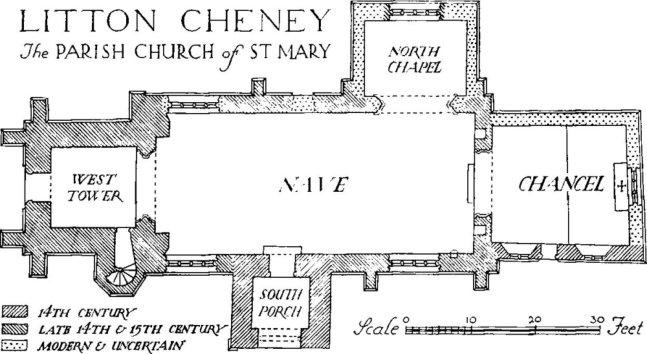
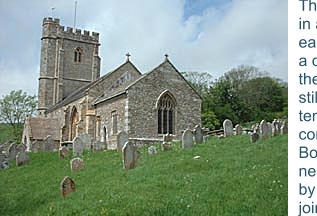
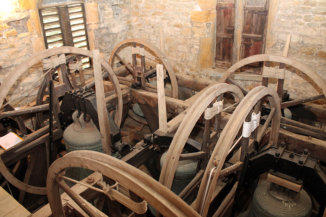
THE RETURN OF THE BELLS

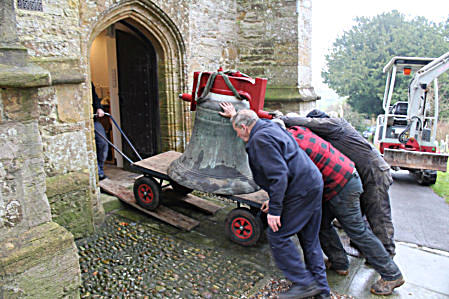
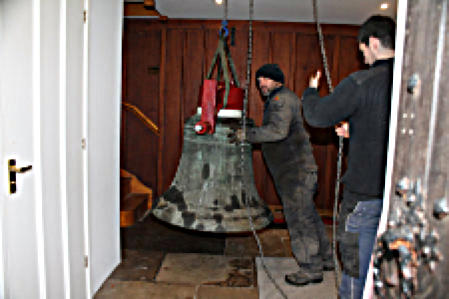
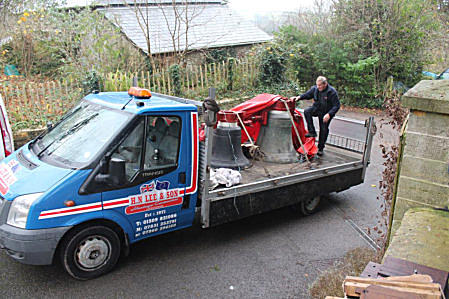
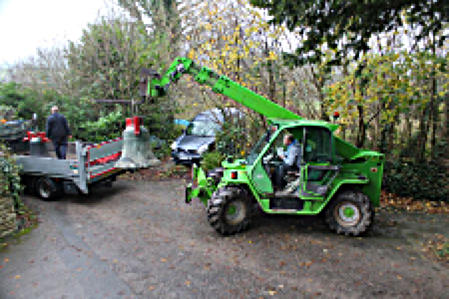
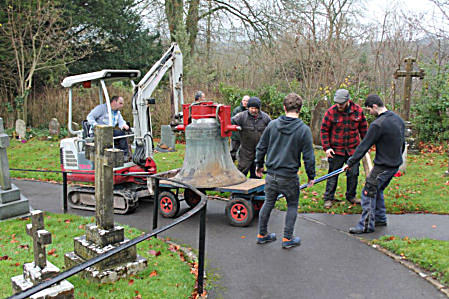

The Parish Church, dedicated to St Mary, is a fine Grade 1 listed building standing in a commanding position overlooking the
village. The oldest remaining parts of the church are sections of the nave, including the south doorway and the porch which
were probably built early in the 14th century. Late in that century the chancel was rebuilt. The north and east walls were
rebuilt yet again early in the 19th century. The tower is of late 14th or 15th century when much of the nave, including the
chancel arch, was built. The church was restored in1878 when the north chapel, now the vestry, was added.
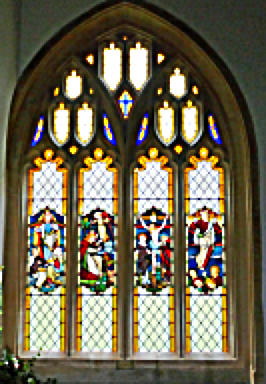
LIST OF RECTORS
Rector
Instituted
Patron
Robert De Everdon
1207
Radolphus de Gorges
Walter Giffard
1299
Sir Ralph de Gorges
John de Kyevely
1317
Baron Lord Gorges of Litton
William Walish
1321
Thomas de la More
1321
Eleanor de Gorges
John Waleys
1348
Walter Waleys
Elias Fynch de Bourton
1361
Bishop of Winton
Adam Kene
1364
Thomas Hyne
1391
Jonh de Wyndsore
William Ayle alias Uberton
1392
Robert Rodelane
1399
Margaret Russell and Sir Ralph Cheyne
William Sylke
1434
Sir Etephen Hatfield Cheyne
John Enderby
1445
Alice Cheyne
John Neweton
1467
John Kemys
William Moyne
1534
James Blunt
Richard Vernon
1548
Lord Mountjoy
William Carlton
1565
Edmund Dier
John Chapman
1572
Ralph Hurding of Ashley
Humphrey Fletcher
1574
Richard Berjew
1593
Elizabeth Colshull
Theophilus Quinton
1639
John Filer
1646
Robert Burbage
John Filer
1680
John Hurding of Longbredy
Francis Fulwood
1690
Philip Henvil
1693
John Pym
1695
William Bendle
1714
George Richards of Longbredy
Thomas Pope
1720
John Sainsbury
1727
Bishop of Bristol (per lapsum)
Robert Bean
1755
Eleanor and George Richards
Edward Colmer
?
George Richards
John Richards
1765
George Frome
1804
Trustees of John Richards
James Cox
1824
Himself
James Septimus Cox
1833
Himself
Frederick Colby
1873
Exeter College Oxford
Frederick Crick
1893
Rev. F. W. Crick
William Cobb
1923
Sir Robert Williams
Edward Daniel
1935
Sir Philip Williams
Wilfred Parsons
1953
Alfred Lynch
1960
Gwyn Lewis
1969
Sir David Williams
Harold George Smith
1979
Sir Philip Williams
As part of the Bride Valley Team Ministry from 1979 and the Bride Valley Team Benefice from 2002:
Tobias Salisbury
1979
Rector
Sir Philip Williams
Harold George Smith
1979
Vicar
Canon John McDougal
1986
Rector
Andrew Salmon
1989
Vicar
Canon John Atkinson
1995
Rector
Anthony Ashwell
1997
Vicar
Bob Thorn
2004
Rector
Canon Stephen Batty
2015
Rector
Jane Williams
2019
Rector
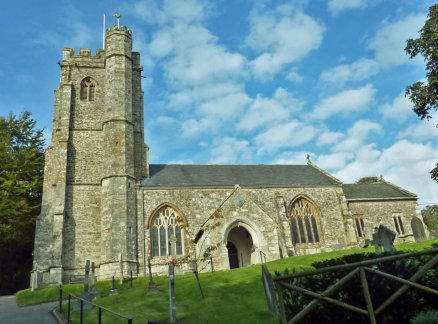
South Face
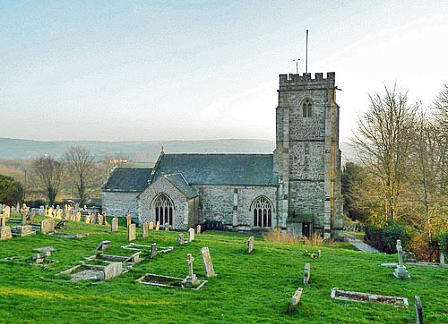
North Face
ST MARY’S CHURCH
They are rung every Sunday morning before the service and for weddings and other notable occasions. Also, on Tuesday
evenings, the bell ringers spend an hour practising.
The bells were refurbished in 2016 by John Taylor & Co of Loughborough.
From the Western Gazette of the 31st of May 1912
LITTON, CHENEY Bell Restoration:
The bells in the Parish Church tower, which have been restored and rehung at a cost of about £50 were formally re-opened on Thursday
last week. The fifth bell, one of the two of the pre-Reformation period in the tower, has been restored at the expense of Mr. C. Fry, as a
memorial to his late father. Mr. T. Fry.
The bells were put to the test at their formal opening on Thursday last, when an enthusiastic team from Bridport and the neighbourhood
visited the village and delighted the countryside with the sweet music of the bells. A full peal of grandsire doubles was rung by the
following team of ringers: Messrs. W. S. B. Northover, J. Zeallv, F. Powel, J. Tompkins (Bndport), Beans, and Lathey (Bradpole).







Village Information v
Local Amenities v
Village Amenities v
About Litton Cheney v
Dorset Council v
Parish Council v